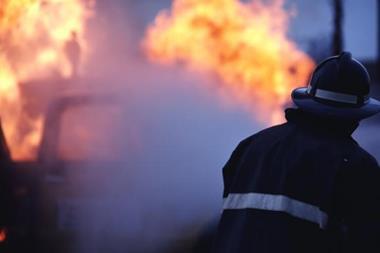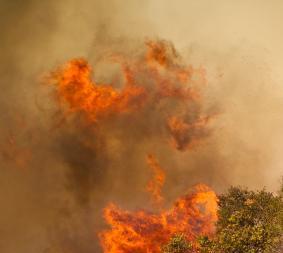The insurance industry could do much to cut the cost of fire cover, writes Chris Hanks. Join his group for a start
The rise in major fires is not only dangerous to life, it destroys properties and businesses – and is leading to an increase in claims.
Figures from the ABI show fire claims reached £865m last year compared with £753m in 2007 – although the highest leap came in 2005, when claims doubled to £900m in a single year. The reasons for the increase include:
- Unless there is risk of loss of life, the fire service will not risk personnel to extinguish a burning commercial building. Fire in these buildings will not be a priority if there are other blazes where people are at risk
- Arson is likely to rise as the recession deepens. This is a tough crime to solve; government figures show only 8% of arson cases are solved compared with 24% of all indictable offences.
- As a result, offenders think they can get away with itn Timber frame construction can pose fire risks. In 2006, a blaze destroyed a timber-framed block of flats that was under construction in Colindale, north London. Although no one was killed, a number of building experts have expressed concerns about this method
- As insurers have little input into building designs, they cannot put forward a case for implementing sprinklers (proven to be effective) at the construction phase.
We are in a market where premiums have fallen about 30%, while broker commissions have risen 5%. We can either do nothing or support the work of Risk Insight, Strategy and Control Authority (Risc), an organisation dedicated to improving outcomes for businesses and reducing the cost of claims for insurers.
I am chairman of Risc – which is at present working on more than 70 projects to improve fire safety – so I am a firm believer in the insurance industry working together in this area. Most of the large composite insurers pay a levy to the authority and support its work. However, there are some notable exceptions – you know who you are – so please join us and make a difference.
Risc was formerly called the Insurers’ Fire Research Strategy Funding Scheme but was rebranded last November. The organisation was set up five years ago to develop and promote best practice in risk control and loss prevention through investment in research, work formerly carried out by the ABI.
It also replaces the Insurers’ Property Crime Research Group, which specialises in arson research. Risc’s remit now also includes security and business continuity.
I want the whole industry to become engaged with this organisation. We provide good value and work on a modest budget for which we are totally reliant on insurers.
We must influence building regulations, build strong relationships with the fire service and lobby the government. The body has specialist working groups, conducts research and lobbies on behalf of UK insurers. It also publishes – through its umbrella organisation, the Fire Protection Association (FPA) – numerous guides and recommendations.
Its role was discussed at a recent seminar held in London, where the key theme was large losses. This event will be followed by regional seminars in Moreton-in-Marsh, Liverpool, York and Glasgow. Visit thefpa.co.uk for details. IT
RISC SEMINAR HIGHLIGHTS
Large losses
Recent research based on 42 fires with a loss value of £50,000 and above found that 0.2% of fires accounted for about 27% of the total fire loss bill. The reasons could include more blazes starting in unoccupied buildings, making them difficult to detect. Paul Woods, senior technical consultant at the FPA, said more information on fires should be available soon, with a new online form being developed with the Chartered Institute of Loss Adjusters.
Fires of special interest
At this seminar, Roy Bishop, deputy commissioner of the London Fire Brigade, talked about modern construction techniques – such as lightweight materials and tight deadlines – and the consequent increased fire risk. He focused on timber-frame construction, which he said was used for one in four social housing projects.
Business continuity and the launch of ROBUST
ROBUST, a free software program developed by Risc, covers business continuity and impact management plans. James Glockling, technical director of the FPA, said it was aimed at small and medium-sized enterprises.
Fire Service perspective on large loss
These are challenging times for the Fire Service: the Audit Commission has recommended a £200m cut from its budget. Charlie Hendry, president of the Chief Fire Officers’ Association, told this seminar about the service’s strategy
– which is now about local planning, rather than national – and questioned whether there was too little emphasis on saving property. He said there was insufficient awareness about business continuity and quoted statistics that eight out of 10 small businesses would not recover from a serious fire.
Building regulations and evidence collection
If insurers want better property protection, they have to collate and present “convincing and substantive” evidence. That’s what Paul Everall, chief executive of Local Authority Building Control, told this seminar. Better alarms and preventive measures also made sense at a time when arson rates were likely to rise, he said.
Property protection
Mike Wood, vice-chairman of the Passive Fire Protection Federation, said a Suffolk leisure centre’s use of fire-retardant glass for some of its construction had helped save much of the interior in a recent fire. Wood added that insurers had to get more involved at the early stages of construction to produce maximum benefit.
Chris Hanks is general manager of Allianz Commercial.
Postscript
FIRE LEVIES: WILL INSURERS HAVE TO PAY?
The devastating bushfires in Victoria (pictured above and below) have led to a public debate in Australia about mandatory insurance for homeowners and small businesses – and the discussion raises interesting questions for the UK, writes Lauren MacGillivray.
In Australia, a fire service levy is charged to insurance companies. Seventy-five per cent of the Victorian fire service’s costs are paid through insurers; they pass on the cost to policyholders. But there is growing controversy that the people who take out insurance pay for the fire services for everyone – including the uninsured. The UK imposes fire levies but only in some locations, including London. As in Australia, this means those with fire protection are funding those without.
But Chris Hanks, general manager of Allianz Commercial, says mandatory fire insurance will not be imposed in the UK – particularly since cover is not compulsory for a bigger threat, floods.
“It’s highly unlikely – we’re not a regulated insurance market [for fire]. We tend to regulate for issues of real catastrophic personal loss such as bodily injury in car accidents, but tend not to do so in property insurance.”
Allianz pays up to £500,000 in fire levies each year, enough to top up the London Fire Brigade’s coffers. But he says this is a fraction of the £300m that the insurer takes in for property premiums.
Allianz passes on the cost evenly to policyholders throughout the UK. “I don’t differentiate between London risks and other risks just for the levy; I differentiate for other reasons,” says Hanks.
Current fire levies are leftovers of a system created after the Great Fire of London in 1666, when property developer Nicholas Barbon introduced the first insurance against fire. He also formed his own fire brigade, a move other companies followed. Policyholders were given a badge to put on their building. Brigades would turn up but would only tackle the fire if the building had the right badge. Property was protected in this way until the early 19th century.
Hosted by comedian and actor Tom Allen, 34 Gold, 23 Silver and 22 Bronze awards were handed out across an amazing 34 categories recognising brilliance and innovation right across the breadth of UK general insurance.














































No comments yet